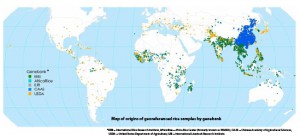Two international centres tout their germplasm collections today. AVRDC’s newsletter, which I just got by email but can’t find on their website, gives a bit of a history lesson:
When AVRDC was founded in 1971, the Center started off with a modest collection of 570 accessions. By 1995, the genebank had grown to 43,205 accessions, comprising 63 genera and 209 species. To date, the Center has accumulated 57,230 accessions comprising 168 genera, 420 species from 154 countries of origin, a growth of 32.5% in number of accessions, 166.7% in number of genera, and 101% in number of species. AVRDC’s vegetable germplasm collections, held as an international public good for the world community, are growing in genetic diversity.
A further snippet of information shows yet again how interconnected the world is for genetic resources. Although “AVRDC is the largest holder of tomato germplasm,” it only includes “9% of the 83,680 accessions held worldwide.”
The same point is made, not quite so directly, but in a more visually striking way, in a map just out in Rice Today (click to enlarge):
And that, dear reader, is why we need a global system, and not just ever more genebanks.

One Reply to “International collections can’t do it by themselves”